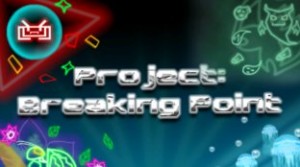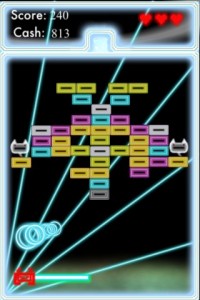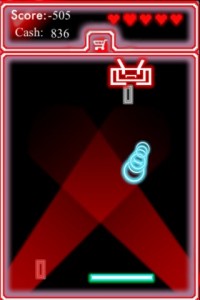 Psychedelic Breakout
Psychedelic Breakout
I’m pretty sure The Men of Honor have brought us a game that accurately reflects what it’s like to have synesthesia. Project: Breaking Point (Out Now for $0.99; Lite) is what would happen if an Arkanoid arcade cabinet suddenly popped up in the middle of a techno rave, and bursts of color bombarded the player’s retinas every time a block were broken.
Sticking close to Breakout genre conventions, Breaking Point has the player sliding a paddle left and right as needed to keep a ball in motion until it smashes through an assortment of tightly packed bricks. What Breaking Point adds is a system of performance-based awards the player can splurge on temporary support items — think extra continues, more than one ball onscreen, and the ability to strike down bricks by simply tapping on them for a limited time. Also available are long-term support Pets, which dutifully serve their role as brick breaker’s best friends by triggering periodic bonuses once they’re purchased and equipped on a select screen.
 Breaking Point‘s dazzling strobe lights are no doubt what will leave the most lasting impression on genre fans who pick it up, but a number of unfortunate quirks flatten this psychedelic experience. To slide the paddle around reliably the player has to grab it directly with his or her finger, which means part of it is always obscured. This deprives the player of absolute certainty that the paddle is positioned as intended, especially once a slight lag in the paddle’s response is factored in: the player’s finger constantly interferes with judgment of where the paddle’s leading edge is.
Breaking Point‘s dazzling strobe lights are no doubt what will leave the most lasting impression on genre fans who pick it up, but a number of unfortunate quirks flatten this psychedelic experience. To slide the paddle around reliably the player has to grab it directly with his or her finger, which means part of it is always obscured. This deprives the player of absolute certainty that the paddle is positioned as intended, especially once a slight lag in the paddle’s response is factored in: the player’s finger constantly interferes with judgment of where the paddle’s leading edge is.
The better method is to slide one’s finger along the thin strip of screen area just below the paddle – one ambiguous picture in the Help menu aside, this is probably what the developer intended – but this area is so slender that significant risk of finger slippage from the touchscreen kicks in. It just so happens the paddle will still respond if the player uses a higher area of the touchscreen for the slide input, but this runs smack dab into another gameplay mechanic — and an innovative one at that. An energy bar lets the player temporarily stop all motion on the playing field or even rearrange bricks by dragging them. This function is activated whenever the player is tapping anywhere onscreen except the paddle, so trying to use relative slide controls higher up on the screen backfires in keeping the energy bar constantly depleted.
Breaking Point could also improve by incorporating visual and audio cues, or at least a tasteful pause, once the ball has fallen off-screen and a replacement dished out. Currently, the game serves up the replacement so fast that it starts bounding around just as the player realizes what’s happened, resulting in a harrowing act of catch-up. My sense is that the developer intended the replacement ball to sit on the paddle until the player manually sends it along with a tap. Absent some pause or other cue, however, the player’s finger is usually still on the paddle once the replacement appears, resulting in a high probability of sending the new ball on its way prematurely. Again, savvy genre fans who know how to make the most out of the thin screen space just below the paddle can get by without experiencing this.
 My last sticking point is the game’s occasional hanging once the player has run out of continues, forcing him or her to manually bring up the level select screen. It appears this specific issue has been addressed in the Lite version, but it still happened – albeit with low enough probability to be tolerable – in the full version on my iPod Touch 4. A more general design weakness that Breaking Point shares with the wider Breakout genre is the potential for extensive lulls in the action, with the ball getting caught up between a wall and unbreakable block formations that it gradually has to work its way out of. You have to be a genre fan to appreciate how these mundane situations can suddenly turn dangerous, and that the player needs to remain vigilant lest the ball fly right past the paddle completely out of the blue.
My last sticking point is the game’s occasional hanging once the player has run out of continues, forcing him or her to manually bring up the level select screen. It appears this specific issue has been addressed in the Lite version, but it still happened – albeit with low enough probability to be tolerable – in the full version on my iPod Touch 4. A more general design weakness that Breaking Point shares with the wider Breakout genre is the potential for extensive lulls in the action, with the ball getting caught up between a wall and unbreakable block formations that it gradually has to work its way out of. You have to be a genre fan to appreciate how these mundane situations can suddenly turn dangerous, and that the player needs to remain vigilant lest the ball fly right past the paddle completely out of the blue.
The Men of Honor pull off some very interesting boss battles to cap off each of Breaking Point‘s four worlds. The game’s aforementioned visual intensity is accompanied by really groovy techno music throughout — although the boss music didn’t start for me until I gave the game a kick by jumping into its in-level item shop menu. Packing in several dozen levels that can be played in the regular Arcade Mode and additionally in a Time Attack challenge mode, Breaking Point easily fulfills the genre fan’s need for sheer amount of content. Despite its flaws, eight to ten hours’ worth of block breaking is nothing to take lightly at the mere price of a dollar!
iFanzine Verdict: While it’s still rough around the edges, Breaking Point has enough content and gameplay depth that it should find a home in the hearts of die-hard genre fans. If you’re a longtime fan of golden oldies like Breakout and Arkanoid and have already exhausted previous iOS titles in that vein, you owe it to yourself to give the Lite a spin and check out the psychedelic visuals at least.
Do beware if you happen to be epileptic; Breaking Point‘s first set of levels is called “RAVE WORLD” for a very good reason!
[xrr rating=3/5]


